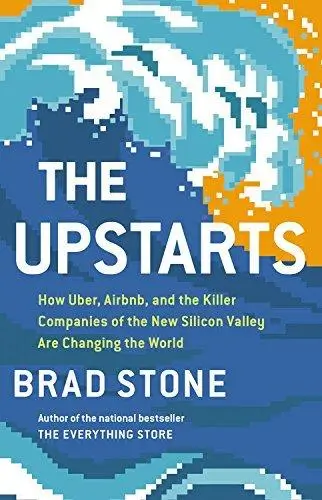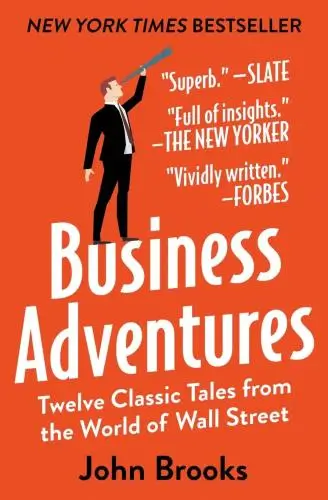Business Adventures
Twelve Classic Tales from the World of Wall Street
What's it about?
Business Adventures by John Brooks is a dive into the high-stakes world of corporate America. This classic collection of twelve true stories offers a timeless insight into the complexities of the business world, from the dramatic rise and fall of companies to the inner workings of Wall Street. Brooks' engaging and detailed narrative reveals the human side of business, making it an essential read for anyone looking to understand the intricacies and challenges of corporate life.
About the Author
John Brooks was an American author and journalist, best known for his insightful analysis of the business world. He authored compelling narratives on Wall Street and corporate America, blending meticulous research with engaging prose. His notable works include "Business Adventures" and "The Go-Go Years," which explore economic booms and busts.
10 Key Ideas of Business Adventures
The Imperative of Understanding Market Psychology for Investment Success
Investing in the stock market is not just about analyzing financial statements and market trends; it's equally about understanding the psychology of other investors.
Market psychology can lead to irrational behavior, causing stocks to be overvalued or undervalued.
Successful investors recognize these psychological patterns and anticipate market reactions, allowing them to make better investment decisions.
By studying historical market events and investor behaviors, one can identify common psychological triggers, such as fear and greed, and learn how to navigate through them.
Learn DeeperKeep a Trading Journal: Document your emotions and the market conditions for each trade. Over time, you'll start to see patterns in how your emotions influence your trading decisions and how market sentiment affects stock prices.
Set Clear Investment Goals and Limits: Before making any investment, define what you hope to achieve and the maximum loss you're willing to accept. This helps mitigate the impact of emotional decision-making in response to market volatility.
Educate Yourself on Market History: Study past market cycles, including bubbles and crashes, to understand how investor psychology has shaped market outcomes. This knowledge can help you recognize when history might be repeating itself.
Practice Mindfulness and Emotional Awareness: Being aware of your emotional state can help you make more rational investment decisions. If you're feeling particularly greedy or fearful, it might be a signal to reevaluate your decision.
Diversify Your Portfolio: Spreading your investments across different asset classes can help reduce the emotional impact of market swings on any single investment, making it easier to maintain a long-term perspective.
- Example
During the dot-com bubble, many investors let greed take over, ignoring traditional valuation metrics and pouring money into internet stocks without solid fundamentals. Those who recognized this irrational exuberance as a psychological trap were able to avoid significant losses when the bubble burst.
- Example
In the 2008 financial crisis, fear led to a massive sell-off in markets around the world. Investors who understood that this fear was driving prices below intrinsic values were able to buy high-quality assets at a discount, benefiting greatly when markets eventually recovered.
The Crucial Role of Effective Communication in Leadership
Leadership extends beyond making strategic decisions; it fundamentally involves communicating those decisions effectively to inspire and guide teams.
Effective communication helps in aligning team members with the company’s vision, ensuring that everyone is working towards the same goals.
It involves clarity, empathy, listening, and feedback.
Leaders who excel in communication can motivate their teams, manage conflicts efficiently, and foster a culture of transparency and trust, which are essential for achieving organizational success.
Learn DeeperPractice Active Listening: Make a conscious effort to listen more than you speak in conversations. This involves maintaining eye contact, nodding to show understanding, and asking follow-up questions to clarify points. Active listening demonstrates respect and helps you gain a deeper understanding of your team's needs and concerns.
Enhance Your Communication Clarity: Before conveying a message, take a moment to organize your thoughts. Aim for simplicity and directness in your language. Avoid jargon that might confuse your audience. If you're communicating a decision or a change, explain the 'why' behind it to help others see the bigger picture.
Provide Regular Feedback: Schedule regular one-on-one meetings with team members to discuss their progress, challenges, and goals. Offer constructive feedback and recognize their achievements. This not only helps in personal development but also strengthens the relationship between you and your team.
Foster an Environment of Open Communication: Encourage team members to share their ideas and concerns without fear of judgment. You can do this by being approachable, responding positively to input, and acting on feedback when appropriate. An open communication culture promotes innovation and problem-solving.
- Example
During a team meeting, a leader notices a team member seems confused about a new project direction. The leader pauses the discussion to address the confusion, explaining the rationale behind the decision and how it aligns with the team's goals. This action not only clarifies the situation for the confused team member but also reinforces the importance of transparency and support within the team.
- Example
A manager receives feedback from her team that they feel overwhelmed by the current workload. Recognizing the importance of this feedback, she arranges a meeting to discuss possible solutions, actively listens to each team member's suggestions, and together they prioritize tasks to manage the workload more effectively. This example shows how a leader can use effective communication to collaboratively solve problems and reduce stress within the team.
Innovation Through Failure: Embracing Setbacks as Stepping Stones
Innovation is not a linear path but a series of trials, errors, and iterations.
Successful companies understand that failure is an integral part of the innovation process.
They create cultures that encourage risk-taking and view setbacks as opportunities for learning and growth.
By analyzing failures without stigmatizing them, organizations can uncover flaws in their strategies or products early, allowing for timely adjustments.
This approach fosters resilience, creativity, and a continuous improvement mindset among teams.
Learn DeeperEmbrace a Growth Mindset: Start viewing failures not as setbacks but as learning opportunities. When faced with a challenge or failure, ask yourself, 'What can I learn from this?' This mindset shift can transform your approach to obstacles, making you more resilient and open to growth.
Cultivate a Safe-to-Fail Environment: Whether you're leading a team or working on personal projects, create an environment where taking calculated risks is encouraged. This means not punishing mistakes but rather analyzing them constructively to glean insights. Celebrate the courage it takes to try something new, even if it doesn't work out as planned.
Implement a Feedback Loop: After any project or task, especially those that didn't go as expected, conduct a review session. Identify what worked, what didn't, and why. Use these insights to adjust your strategies or processes moving forward. This continuous improvement cycle can lead to significant innovations over time.
Document Your Learnings: Keep a journal or log of challenges you've faced, the actions you took, and the outcomes. Over time, this documentation will become a valuable resource for understanding patterns in your successes and failures, helping you make more informed decisions in the future.
- Example
A tech startup launches a new app feature based on initial user feedback but it fails to gain traction. Instead of scrapping the project, the team conducts user interviews to understand the disconnect. They learn that the feature was too complex for the average user. Using this feedback, they simplify the feature and relaunch it successfully.
- Example
A marketing team runs a campaign that performs below expectations. Rather than viewing this as a failure, they analyze the campaign data to understand where they missed the mark. They discover that their target audience was broader than they thought, leading to diluted messaging. For their next campaign, they segment their audience more precisely and tailor their messaging, resulting in a significant increase in engagement.
The Strategic Advantage of Diversification in Business Operations
Diversification is a strategy used by companies to expand into new markets or product lines, reducing dependence on a single source of revenue.
This approach mitigates risks associated with market volatility, economic downturns, or changes in consumer preferences.
By spreading investments across different areas, companies can stabilize their income streams and capitalize on growth opportunities in various sectors.
However, diversification requires thorough market research, strategic planning, and the ability to integrate new ventures seamlessly into existing operations.
Learn DeeperIdentify Your Core Competencies: Start by understanding what your business does best. This could be a particular product, service, or even a process. Knowing your strengths will guide you in exploring new markets or product lines that can complement your existing operations.
Conduct Market Research: Before diving into new ventures, invest time and resources in thorough market research. Understand the needs of the potential market, the competition, and any barriers to entry. This step is crucial to ensure that your diversification efforts are not based on assumptions but on solid data.
Evaluate Your Resources: Assess whether your current resources, including capital, personnel, and technology, can support the expansion. If not, plan how you will acquire the necessary resources. This might involve hiring new talent, seeking additional funding, or investing in new technologies.
Develop a Strategic Plan: Create a detailed plan outlining how you will enter the new market or launch the new product line. This should include marketing strategies, sales targets, and operational plans. Ensure that this plan aligns with your overall business goals.
Start Small and Scale Gradually: Instead of making a significant investment upfront, consider starting on a smaller scale. This could mean testing the new product in a limited market or gradually expanding services. Scaling gradually allows you to manage risks better and make adjustments based on initial feedback.
Monitor and Adjust: Once you've diversified, continuously monitor the performance of your new ventures. Be prepared to make adjustments based on what's working and what's not. This might involve tweaking your products, changing your marketing strategy, or even exiting a market if it doesn't meet your expectations.
- Example
A technology company that primarily develops software for the finance sector diversifying into cybersecurity solutions, recognizing the growing demand for security in digital transactions.
- Example
A local bakery that specializes in bread expanding its product line to include pastries and cakes, and later opening a café to serve their baked goods directly to consumers, leveraging their reputation for quality.
Understanding and Leveraging the Power of Corporate Culture
Corporate culture, the shared values, beliefs, and practices within an organization, significantly influences its performance and employee satisfaction.
A strong, positive corporate culture enhances teamwork, drives engagement, and attracts top talent.
It also shapes decision-making and customer interactions, directly impacting brand reputation and loyalty.
Companies that actively cultivate a culture aligned with their strategic goals create a competitive advantage, fostering innovation, efficiency, and adaptability in the face of change.
Learn DeeperAssess Your Organization's Culture: Start by understanding the current culture of your organization. Conduct surveys, hold focus groups, or have informal discussions to gauge the values, beliefs, and practices that are prevalent. This will help you identify areas of strength and those needing improvement.
Define Your Ideal Culture: Clearly articulate the kind of culture you want to cultivate that aligns with your strategic goals. This could involve values like innovation, teamwork, customer focus, or integrity. Make sure these values are specific, achievable, and measurable.
Communicate and Embed Cultural Values: Use every opportunity to communicate the desired culture through meetings, newsletters, and company events. Leadership should model these values in their behavior, decisions, and how they manage people. Recognize and reward behaviors that align with these values to reinforce them.
Review Policies and Practices: Ensure that your company policies, procedures, and practices support the desired culture. This might involve revising performance evaluation criteria, changing hiring practices to focus on cultural fit, or modifying how teams are structured and projects are managed.
Monitor, Measure, and Adjust: Regularly check the pulse of your organization's culture through surveys and feedback mechanisms. Be prepared to make adjustments as needed to ensure the culture remains aligned with your strategic goals, especially as the external environment changes.
- Example
A tech startup wants to foster a culture of innovation and agility. They start by holding a company-wide workshop to define what innovation means to them and how it can be manifested in daily work. They then introduce 'hack days' where employees can work on any project they choose, encouraging creative thinking and experimentation.
- Example
A retail company aiming to enhance customer satisfaction decides to embed this value into their culture. They begin by training their staff on new customer service techniques and introduce a reward system for employees who go above and beyond in serving customers. They also adjust their return policies to be more customer-friendly, reinforcing the importance of customer satisfaction in every aspect of their operations.
Deeper knowledge. Personal growth. Unlocked.
Unlock this book's key ideas and 15M+ more. Learn with quick, impactful summaries.
Read Full SummarySign up and read for free!
Business Adventures Summary: Common Questions
Experience Personalized Book Summaries, Today!
Discover a new way to gain knowledge, and save time.
Sign up for our 7-day trial now.
No Credit Card Needed

Similar Books

$100M Offers
Alex Hormozi
Principles of Marketing, Global Edition
Gary Armstrong
The 100 Best Business Books of All Time
Jack Covert
Playing to Win
A.G. Lafley
Productize
Eisha Armstrong
Start Your Own Pet-Sitting Business and More
Entrepreneur Press
The 22 Immutable Laws of Marketing
Al Ries
The Upstarts
Brad Stone
Lean Analytics
Alistair Croll
Built to Sell
John WarrillowTrending Summaries

Peak
Anders Ericsson
Never Split the Difference
Chris Voss
Smart Brevity
Jim VandeHei
The Psychology of Money
Morgan Housel
The First 90 Days
Michael D. Watkins
Atomic Habits
James Clear
Thinking, Fast and Slow
Daniel Kahneman
The Body Keeps the Score
Bessel van der Kolk M.D.
The Power of Regret
Daniel H. Pink
The Compound Effect
Darren HardyNew Books

The Art of Spending Money
Morgan Housel
$100M Offers
Alex Hormozi
A Candle for Kiri
Edna Mae Holm
Principles of Marketing, Global Edition
Gary Armstrong
Serpent Rising: The Kundalini Compendium
Neven Paar
Feeling Is the Secret
Neville Goddard
The 100 Best Business Books of All Time
Jack Covert
My Oxford Year
Julia Whelan
Trading in the Zone
Mark Douglas

